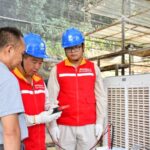Think it’s just a mosquito bite? No, it could be chikungunya knocking at your door. The Chongqing Center for Disease Control and Prevention has reminded the public that there is currently no specific treatment for chikungunya, and the key to prevention lies in mosquito control. Detailed information about its symptoms and preventive measures has also been provided.
Chikungunya is an acute viral disease caused by the chikungunya virus and transmitted through the bites of Aedes albopictus and Aedes aegypti mosquitoes. People of all ages can be infected. While most patients recover within a week, 30%–40% of infected individuals may experience joint pain lasting months or even years, severely affecting their quality of life.
As of December 2024, 119 countries and regions worldwide have reported local transmission of chikungunya, with outbreaks mainly concentrated in Africa, the Americas, and Asia. China first reported imported cases in 2008. Although it has not become an endemic area, localized outbreaks have occurred in Guangdong, Yunnan, Zhejiang, and other regions. In July 2025, Foshan City in Guangdong Province experienced a local transmission outbreak triggered by imported cases, making this a critical period for prevention and control.
What symptoms appear after infection? Generally, symptoms develop within 3–7 days after a bite and include sudden high fever (>38.5°C), severe joint pain (often in small joints like wrists, ankles, and toes), muscle pain, headache, rash, nausea, and extreme fatigue. Additionally, a small number of patients may develop complications affecting the eyes, heart, or nervous system. The disease can be confirmed through laboratory tests detecting viral RNA or specific antibodies.
There is currently no specific treatment for chikungunya. Supportive care includes rest, hydration, and medications like acetaminophen to relieve fever and pain. Importantly, aspirin or ibuprofen should not be used until dengue fever is ruled out, as they may increase the risk of bleeding.
China is not an endemic country for chikungunya, and no licensed vaccine is currently available. Since the general population is susceptible, personal protection and avoiding mosquito bites are essential for prevention:
For personal protection, wear light-colored long sleeves and pants when outdoors. Apply insect repellent containing DEET or picaridin to exposed skin and treat clothing with permethrin-based repellents. Avoid outdoor activities during peak mosquito hours. Indoors, install window and door screens, inspect them regularly for damage, and minimize opening doors and windows in the evening. Use mosquito nets while sleeping, especially for vulnerable groups like infants and the elderly. Physical methods like electric mosquito swatters or traps can also help.
For environmental management, eliminate standing water weekly in containers such as vases, flowerpot trays, buckets, and discarded tires—store them upside down when empty. Clean drains, floor sinks, and washing machine outlets regularly to prevent water accumulation. Outdoors, fill tree holes and rock crevices with sand, and clear gutters and rooftops to avoid water buildup. High-risk areas like construction sites and waste storage zones require regular inspections.
With summer travel at its peak, travelers should take precautions: check for outbreaks at their destination before departure. Pregnant women and those with chronic conditions should reconsider travel plans. After returning, continue mosquito prevention for two weeks to avoid potential virus transmission.





